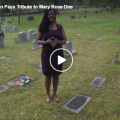
On April 28, 1983, an eight-year-old boy playing by his yard near Little Rock’s Cantrell Road discovered baby Mary Rose Doe lying dead in a drainage ditch.
Mary was 16 inches long and weighed five pounds. She was seven months gestation, with a full head of auburn hair, brown eyes, and ivory skin.
The State Medical Examiner’s autopsy determined Mary asphyxiated in the womb as a result of a legal abortion.
Mary’s lifeless body was delivered and — for reasons nobody has ever been able to determine — she was abandoned in a drainage ditch. She probably had been dead only a few hours when her body was found.
The State Medical Examiner described Mary as “a perfect little bud that was clipped before she could blossom.”
Mary’s death serves as a grisly reminder of the horrors of unrestricted abortion on demand.
In 1983 abortion was legal and largely unregulated in Arkansas.
In the spring of that year, the state legislature passed Act 509 instituting some of Arkansas’ first meaningful restrictions on abortion facilities. However, those regulations did not take effect for many months. None of them was in place when Baby Mary Rose Doe was aborted—and then abandoned—in Little Rock.
Abortions like the one that took Mary Rose Doe’s life are one reason Arkansas began enacting pro-life laws such as health and safety standards for abortionists and abortion facilities.
In May of 1983, North Pulaski Pro-Life assumed guardianship of Mary’s remains, and the group made arrangements for her burial.
North Pulaski Pro-Life’s Treasurer and his wife provided Mary with a dress that had belonged to their daughters.
North Little Rock Funeral Home gave her a small coffin. The Catholic Diocese of Little Rock provided her with a grave plot in Little Rock’s Calvary Cemetery.
And North Pulaski Pro-Life gave her a name: Mary Rose Doe.
On May 16, 1983—less than three weeks after her body was found—some 100 people attended a graveside service for Mary at Calvary Cemetery in Little Rock. According to a news report at the time, the group sang “Amazing Grace” and heard from two ministers—one a Church of Christ preacher and the other a Catholic priest—who both called for an end to abortion.
White linen, rosebuds, and daisies covered Mary’s casket. A small marker was placed on her grave—a memorial to Mary Rose Doe and the thousands of other unborn children aborted in Arkansas.
Today, abortion in Arkansas is generally prohibited except to save the life of the mother. Mary’s body rests in a quiet corner of Calvary Cemetery near the intersection of South Woodrow and Asher Avenue in Little Rock. Her grave lies just a short drive across town from the place her body was discovered 41 years ago.
Mary’s story is still relevant. Right now an effort is underway in Arkansas to write abortion into the state constitution; this would threaten to nullify even basic health and safety standards for abortionists and abortion facilities. Arkansas has been down that road before. Mary Rose Doe’s brief life and tragic death remind us exactly what unrestricted abortion on demand looks like.
Articles appearing on this website are written with the aid of Family Council’s researchers and writers. Information in this article was adapted from Family Council’s update letter dated April of 2020 and from news articles published in 1983.




